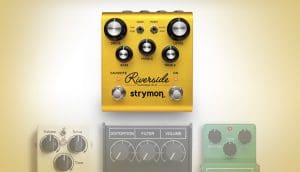
Can Riverside replace my ______?
In the last few weeks, we have received quite a few questions about Riverside. Here are a few: Is Riverside a tube screamer clone? Is Riverside supposed to sound like
Free US Shipping On Orders Over $49
Easy 30-Day Returns
Financing Available Through ![]()
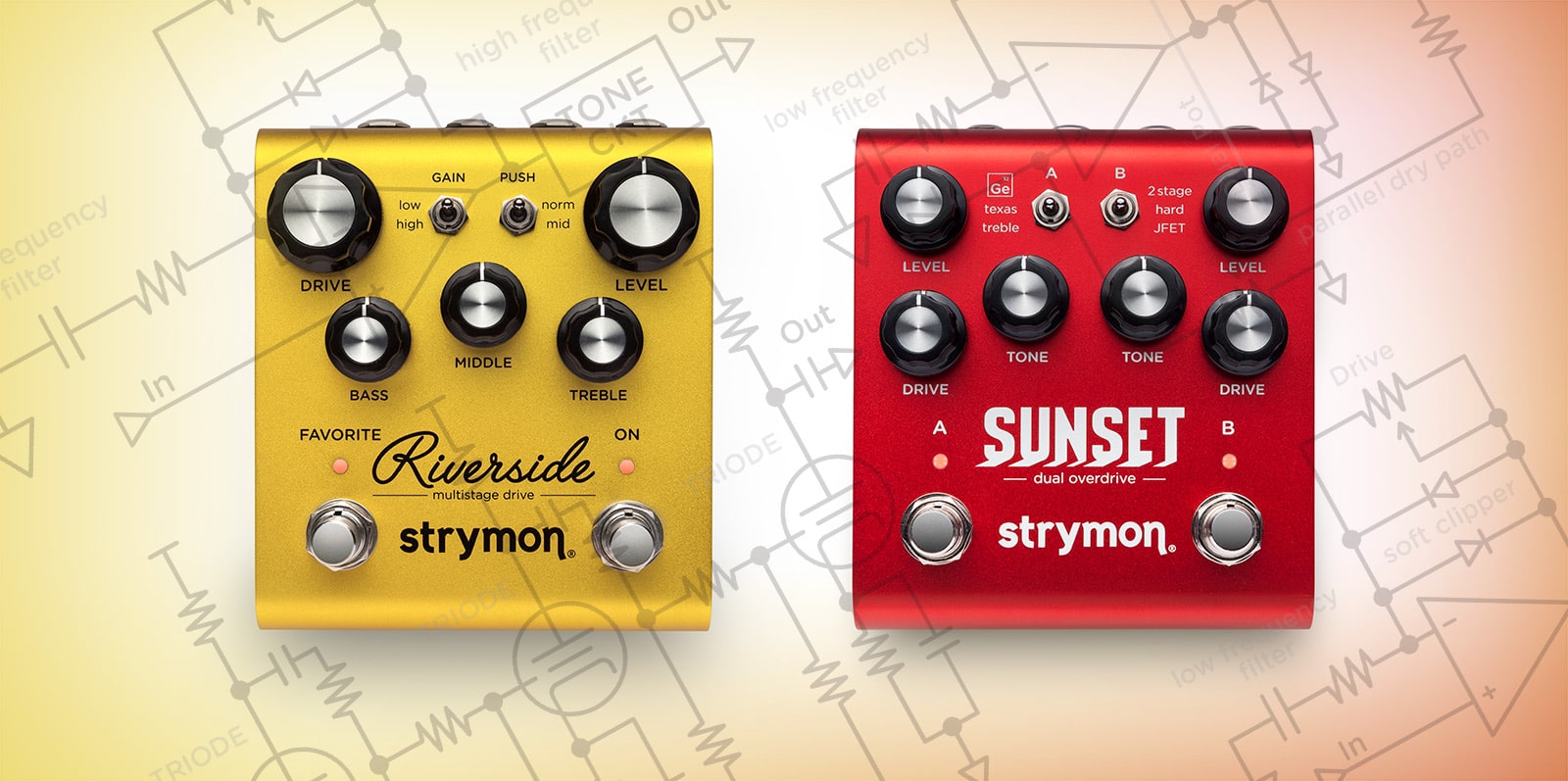
Although both Riverside Drive and Sunset Dual Overdrive share similarities, they are two very different beasts.
Riverside‘s sound, dynamics, and feel are like that of a multistage tube preamp with cascading gain stages. The clipping in these gain stages is based on the clipping characteristics of preamp tubes. Riverside can be truly thought of as an “amp in a box” pedal.
Sunset‘s overdrive circuits are based on diode clipping circuit types found in classic overdrive pedals. We carefully voiced each circuit to deliver a superlative tone and playing experience. You can select from six different drive circuits, and stack two drives at once, essentially giving you two overdrive pedals in one unit.
In the White Paper below, Strymon Co-Founder and DSP Engineer Pete Celi provides an in-depth look at single stage and multistage gain topologies, and how they create the wide range of drive tones that we know and love.
Many classic pedal gain circuits are a single-stage gain topology, meaning the gain is achieved in one section in the signal path. These circuits may have an input buffer stage whose job is to provide a high input impedance and condition the signal, and/or an output buffer following the gain stage for driving long cables and subsequent pedals, but the actual gain and clipping is achieved in one stage. Sunset features six different classic topologies to cover a wide range of boost and overdrive pedal styles.
Cascading multistage gain structures are found in the preamp sections of high gain tube amps. In contrast to single stage circuits, they create gain and clipping by connecting several lower gain stages in series with each other. By spreading the gain over several stages, a varying harmonic structure is achieved as the stages go in and out of clipping. The interstage circuitry is a critical part of the design of this type of structure. Riverside uses a cascading multistage topology to achieve its wide array of preamp drive tones.
A boost adds gain with little, if any, clipping of the guitar signal. It’s a volume boost that allows you to drive the front end of your amp harder. Boosts commonly use a JFET transistor for the gain stage to provide the high impedance, lower gain, and mild clipping characteristics that are desirable in a boost. Any clipping that happens is a result of the amplified signal exceeding the linear portion of the gain stage as determined by the input signal level, the amount of gain, and the power rails.
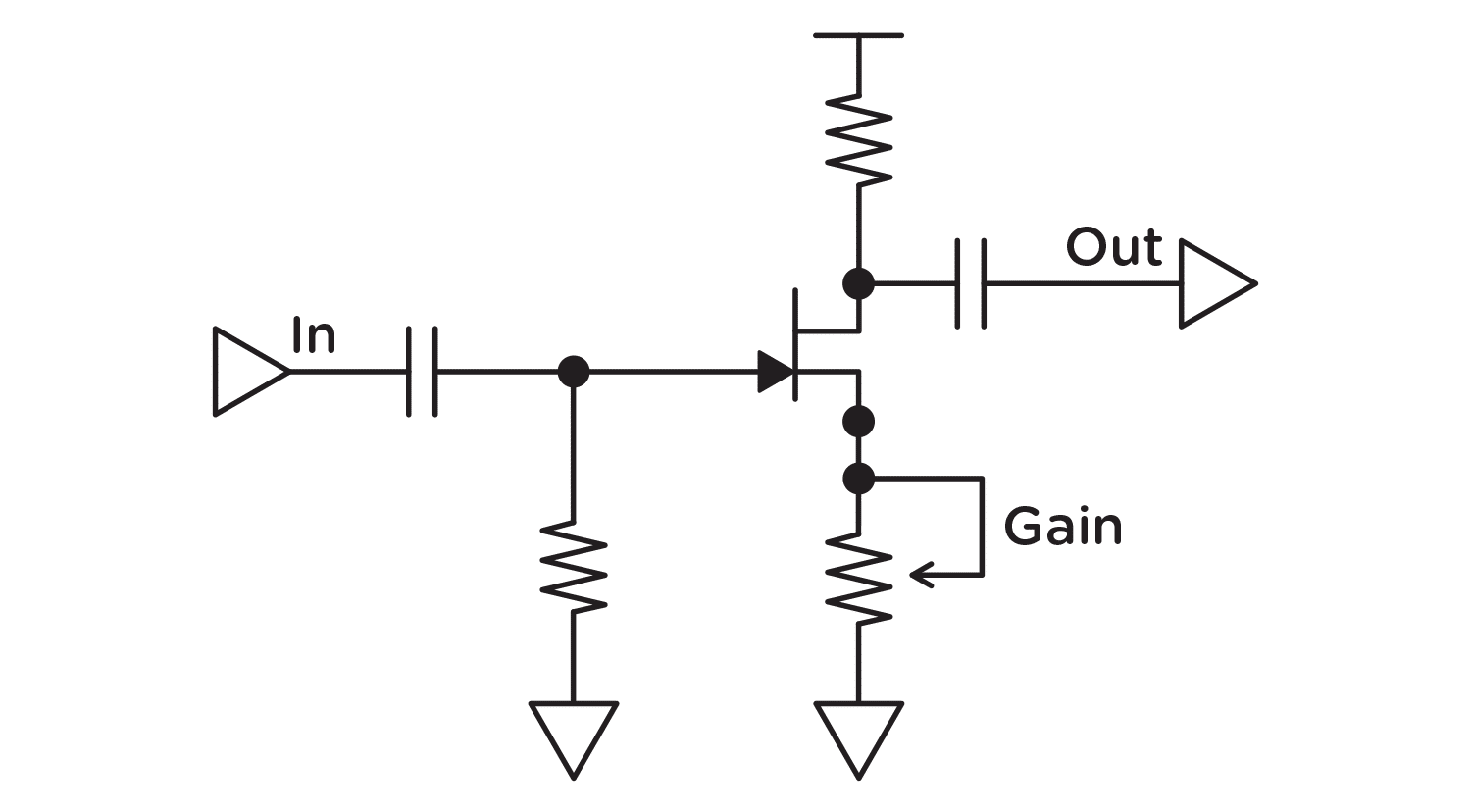
Fig 1. JFET Boost Circuit
Boosts can be used at the front of the signal chain to buffer and drive subsequent pedals, or at the end to act as a volume boost or a solo boost, or to drive an already overdriven amp even harder. The Strymon Sunset ‘JFET’ type is based on this topology. It adds warmth and dimension, while adding just a hint of mild breakup at high Drive settings. The ‘Treble’ type is a higher headroom boost that can remove the low frequencies for a sharp tone to tighten up and push amps or other pedals.
The most common circuit topology for overdrive pedals is known as a ‘soft clipper’. Typically, an op amp or high gain BJT (Bipolar Junction Transistor) is used to achieve the gain, and clipping is achieved with diodes connected in the feedback path of the gain stage. Low frequencies are usually filtered before the gain stage, and high frequencies are filtered after the gain for a responsive mid-pushed character with a smooth top end.
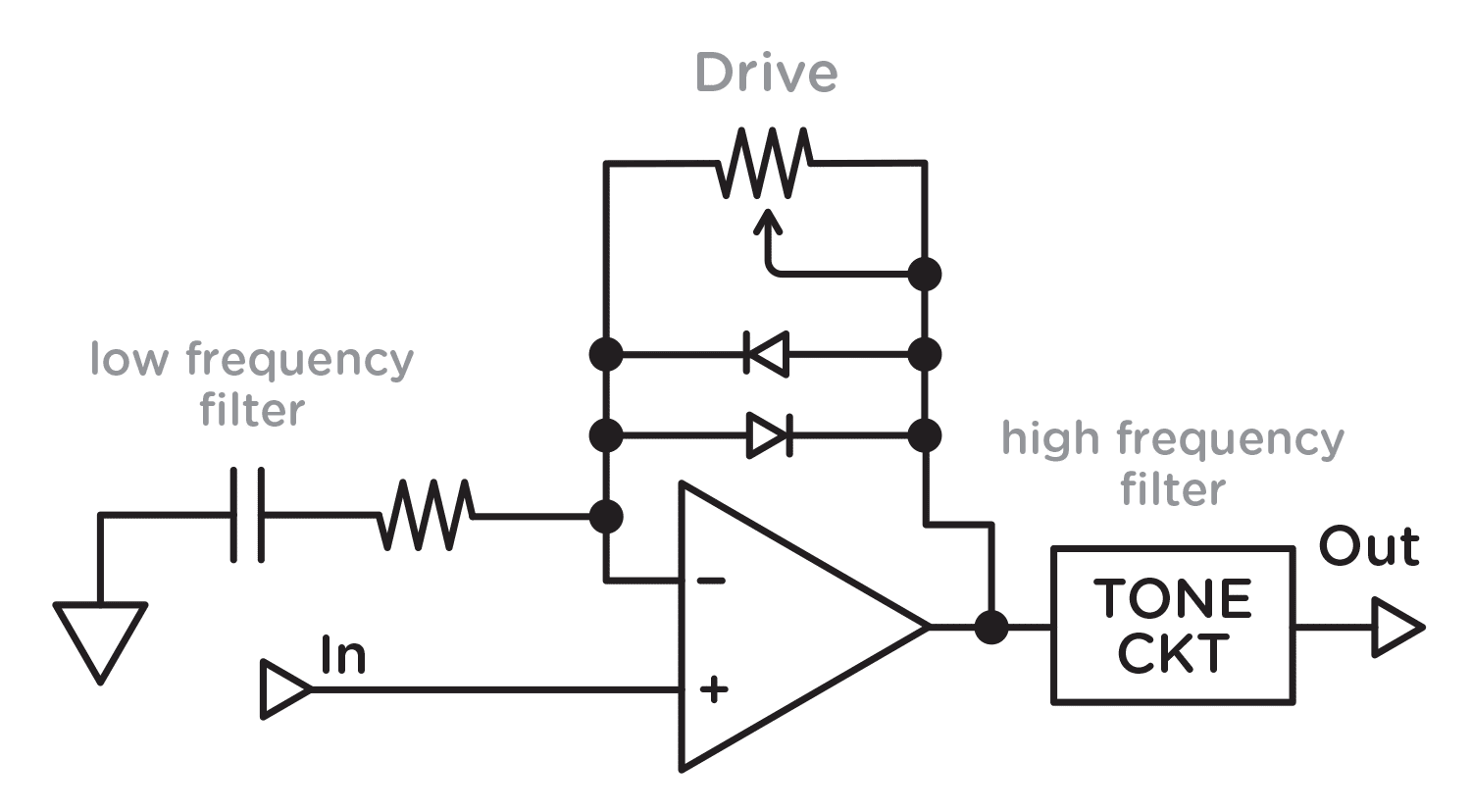
Fig 2. Feedback Soft Clipper Circuit
The properties of this configuration are such that the input transient dynamics are preserved at the output. As you dig in harder, the clipped portion of the signal creates more harmonics but does not get ‘louder’, while the input signal is passed through with its associated dynamic peaks, retaining clarity. This is great for situations where the amp is already working fairly hard, and you are looking to get a dynamic push with the pedal in front. The Strymon Sunset ‘Texas’ type is based on this topology.
Another way to produce a soft clipped result is with a circuit topology that uses a hard clipper topology (more on that soon) with a separate parallel path where the input signal is explicitly mixed in with clipped signal. This manner allows for a tailored approach to the dynamic response as the Drive is increased. The Strymon Sunset ‘Ge’ type is based on this topology, voiced for a strong response in the low-mid frequencies.
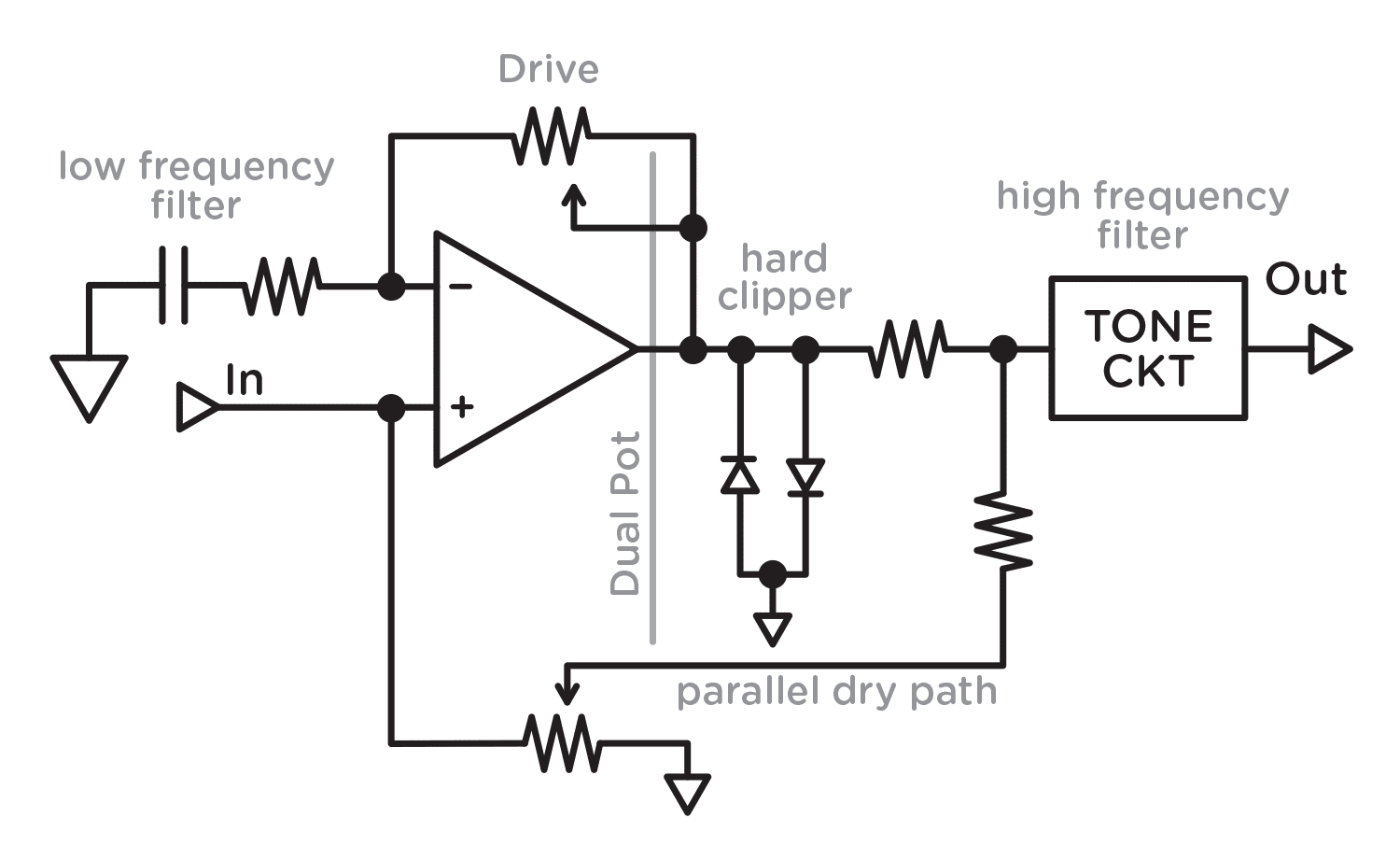
Fig 3. Parallel Path Soft Clipper Circuit
Hard clippers are found in many distortion pedals. The clipping diodes are connected to the output of the gain stage so that they ‘chop off’ the peaks of the gained up input signal. They typically have more gain than overdrive pedals, but a more fundamental difference is how the hard clipper reacts to input dynamics. Instead of passing transient peaks to the output, the hard clipper will create more harmonics in response to higher input levels. This translate to a different feel from the soft clipper. You can still ‘work’ the dynamics by digging in and varying your playing intensity, but it’s about fattening up and driving harder as opposed to retaining the original clarity of the input dynamics.
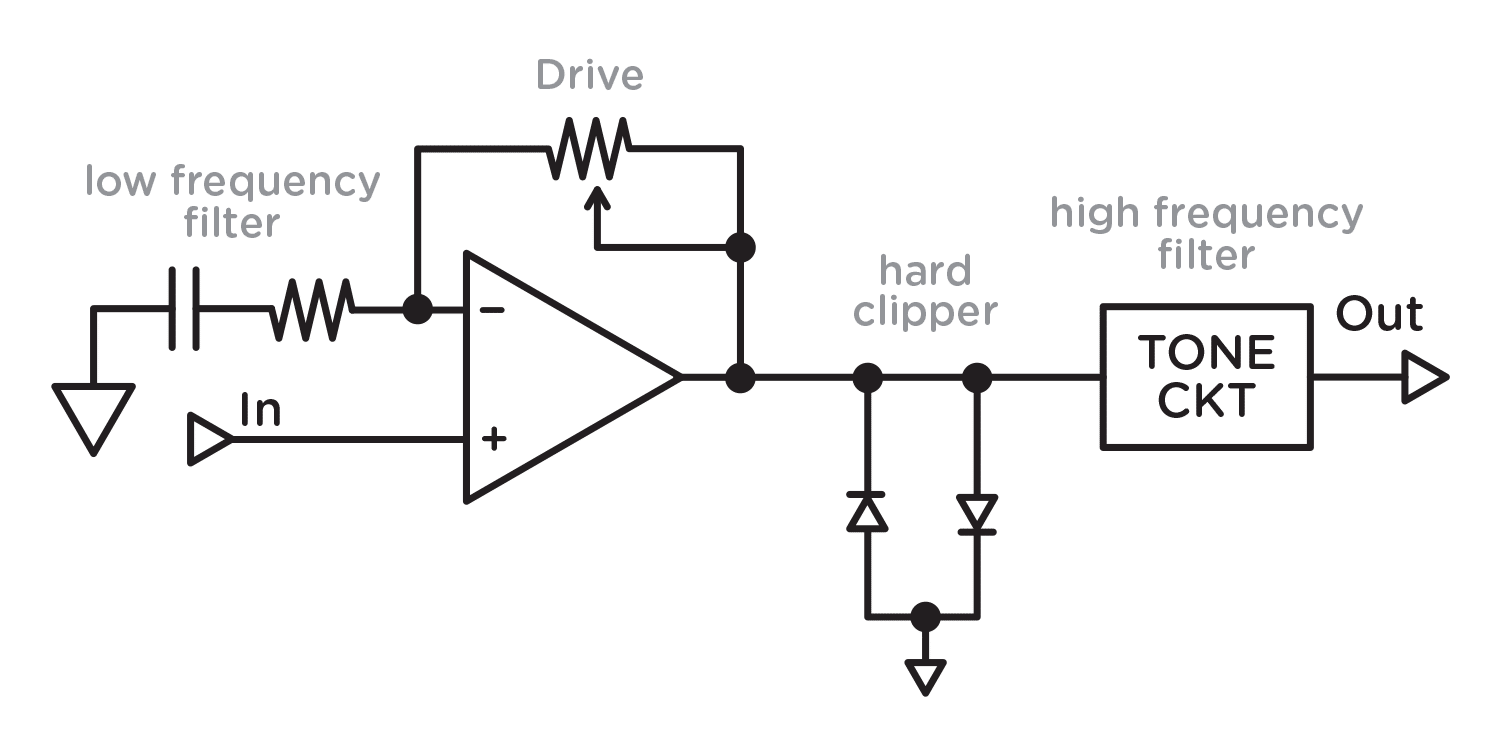
Fig 4. Hard Clipper Circuit
The same filtering philosophy as overdrive pedals generally applies to distortion pedals as well. The low frequency filter may be more aggressive to keep the low end tight at high gain settings, while the increased harmonics can create a broad top end response that has some sizzle. A more relaxed low frequency filter results in a looser, ‘fuzzier’ response. The higher gain range lends itself to using the guitar volume knob to control the amount of drive. Hard clippers work well with cleaner amp tones, allowing the harmonics to be generated by the pedal. The Strymon Sunset’s ‘Hard’ type is based on this style of circuit, with a wide range of gain available from mild to heavy.
Another topology for overdrive and distortion combines the soft clipper with the hard clipper. A traditional soft clipper stage creates the transient clarity and dynamics, and is then passed to a hard clipper through a network. There is still only a single gain stage, but there are two clipping stages. Depending on the network and diode configuration, the two-stage configuration can be tuned from a soft clipper to a hard clipper to anywhere in between, allowing some of the soft clip dynamics through before being hard clipped at a second stage. The Strymon Sunset’s ‘2-Stg’ type is based on this versatile topology with a fair amount of gain on tap.
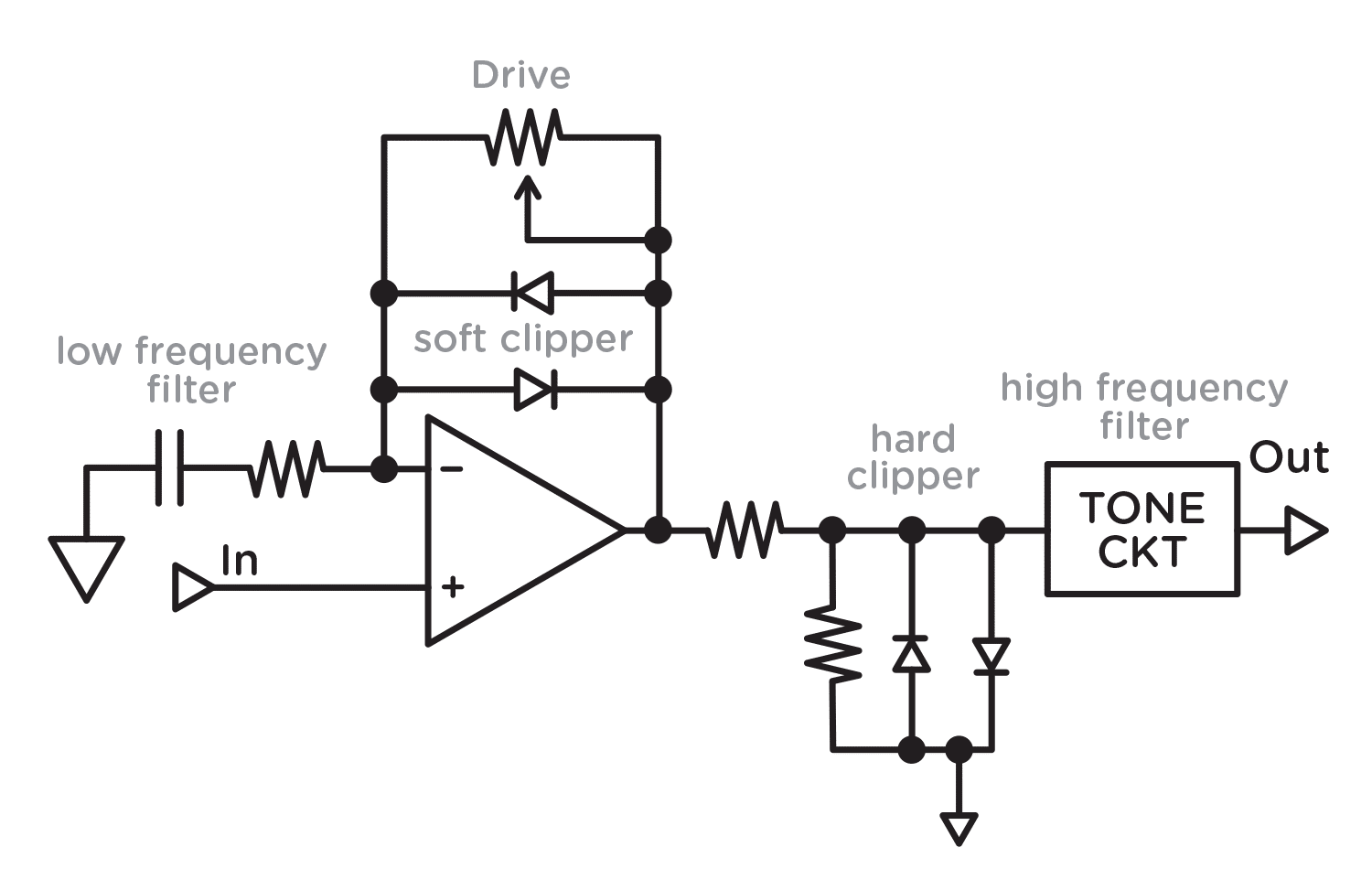
Fig 5. Two stage Clipper Circuit
The op-amps and transistors used in the single gain stages are capable of producing gain well beyond what is needed for a gain pedal. The gain stages use resistive feedback to set the gain to the range that’s needed. For reference, a typical boost pedal may have 20dB of gain, an overdrive typically has 40dB or 50dB, and a distortion pedal may have 60dB or 70dB of gain.
Preamp tubes have far less gain than op amps, so several tubes stages need to be cascaded to create high gain. This was the approach used in the designs of the first high-gain tube amps, which started by ‘hot-rodding’ some of the traditional designs. The cascading tube stages create a harmonically complex signal that changes as the individual stages go in and out of clipping. The resistors and capacitors form networks that determine the gain, frequency response and output levels of each stage as the signal passes from one section to the next, and play an important role in this aspect of performance.
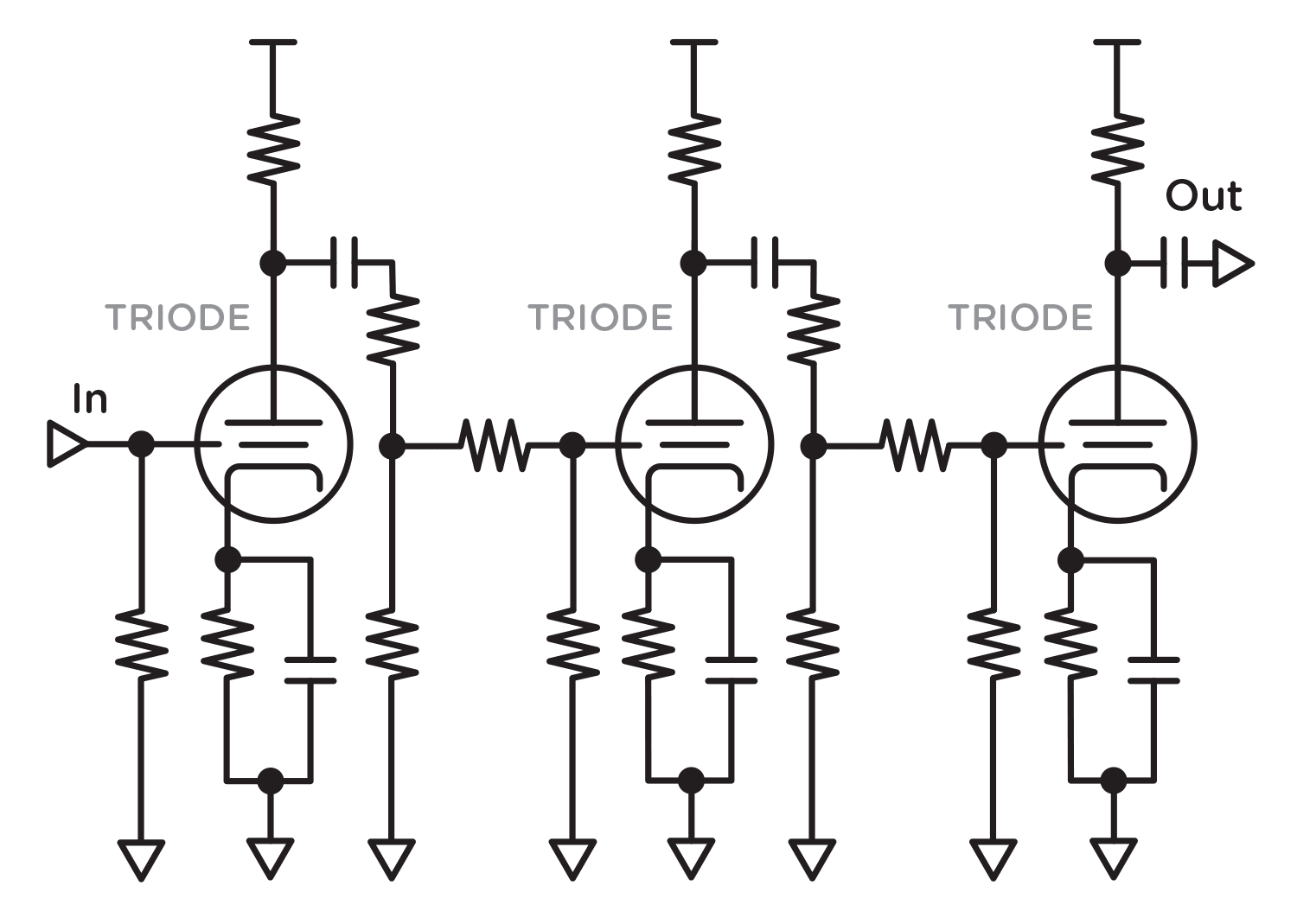
Fig 6. Multistage Tube Gain Circuit
The clipping characteristics of the preamp tubes are asymmetrical, meaning one half of the waveform gets clipped harder than the other half. Each stage inverts the polarity of the signal which, combined with the asymmetrical clipping, results in shifting bias points in response to transients dynamics and sustained signal decay. The dynamic response and feel is different from either a hard clipper or soft clipper due to the interaction of the multiple stages.
Stymon’s Riverside Drive uses a multistage topology that consists of four cascading (series) gain stages to create harmonics and varying levels of drive. The first gain stage is a discrete Class A JFET gain stage, and the following three gain stages are based on the asymmetric clipping characteristics of preamp vacuum tubes configured as shown above. Riverside’s continuously variable circuit tuning adjusts the values of the interstage circuitry as the Drive knob is turned to allow for optimal tuning of these components from clean to saturated gain.
Traditional single stage gain topologies are used for a diverse array of classic boost, overdrive and distortion pedal tones. Multiple cascaded gain stages are used to create tube-style preamp tones ranging from clean to heavy distortion.
Subscribe to our newsletter to be the first to hear about new Strymon products, artist features, and behind the scenes content!

In the last few weeks, we have received quite a few questions about Riverside. Here are a few: Is Riverside a tube screamer clone? Is Riverside supposed to sound like
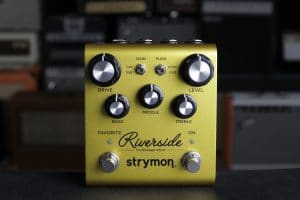
We’re excited to announce that our new Riverside Multistage Drive pedal is now available! Riverside’s variable circuit tuning tweaks multiple parameters under the hood so that the
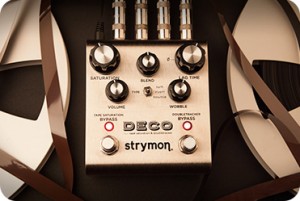
Our journey begins with some of the earliest recording studios. The introduction of reel-to-reel tape machines and the creative engineers that used them brought on
18 Responses
I can’t wait to drive this into my Riverside.
I am 57 and have been playing guitar for almost 40 years. The summary comparison of your Riverside and Sunset circuits was one of the clearest explanation I have ever read on the topic. Thank you for your efforts and engineering accomplishments.
Miguel
I agree with Miquel. This was a well written piece – thank you.
I’m not sure I understand the difference in tones, between these two pedals.
I purchased the Riverside Drive with the Favorite Switch as a Boost. It has replaced my Ibanez Tube Screamer and MXR Custom Badass 78′ distortion. The Riverside Covers the “tonal space” two pedals perfectly with the Bass, Mid, and Treble controls and makes my AC15 sing.
Can’t wait to sample the Sunset, but I think I’m good, at least for now.
Cheers.
@David – The drive tones generated by these two pedals are produced in different manners through the use of a JFET analog input stage and DSP circuit algorithms. With Riverside, you get a sound more akin to that of a multi-stage tube preamp. With Sunset, you get 6 different drive circuit varieties similar to classic stompboxes. Though they both produce overdrive/distortion sounds, the tones generated between the 2 can be quiet different from each other. If online videos don’t convey these differences, the best way would be by giving them a try with your own gear. 🙂
Correct me if I’m wrong, but the Riverside with it’s cascading gain stages is not really supposed to be a “pedal replacement”. It’s kind of its own animal with its multistage circuitry. Out of curiosity, and with all these YouTube comparisons and everything, wouldn’t a better comparison be the Riverside against other multistage preamps from different amp manufacturers?
@Tyler – Yes, you are correct that Riverside would fit better in comparisons with other preamps over overdrive pedals.
I have purchased both the Riverside and Sunset overdrive pedals and while the Riverside is a great pedal and very useful in it’s own right, for my money (and ears) the Sunset “nails” the overdrive sound(s) I am looking for. It seems to have a new and different overdrive sound / tone with every tweak of each control on every setting. That means that there is a place for this pedal to be found after virtually any guitar and before almost any kind of amp. Nothing sounds bad or “mismatched”. But perhaps the thing I appreciate most is the way that the pedal responds at all volume levels. How many times have we achieved what we are looking for at one volume level but lose that “space” when the volume is turned down. In my opinion this pedal excels at low volumes so you can find your “sweet spot” anywhere and then just turn your amp up to the desired volume level. A lot (perhaps most) overdrive pedals seem to want to take over your amp at anything below higher volume settings. This pedal allows you to find what you are looking for anywhere on the volume dial. I am somewhat surprised that Strymon introduced this pedal so closely following the launch of the Riverside – but I’m sure glad they did. In a word – “OUTSTANDING”.!!!
Dan thanks, thats a great contribution. Science doesn’t prove the sound and isn’t helpfull to make a choice.
I am exceptionally satisfied with my Riverside, it did take a few hours to discover it’s finer points and dial-ups, but now I’ve got two great drive tones with the utilisation of the favourites button. I may add an expression pedal to discover more.
It stacks really well with my compressor in front of it !
Now I wonder, with the premise of it utilised as a pre-amp, how it would interact with a stacking that has the Sunset in front of it and after my compressor.
I know, get one and find out, but I am curious as to whether any of your team or players out there have looked in on that Sunset Riverside stacking ?
@John – We’re glad to hear that you are enjoying your Riverside pedal! There are several of us that use Sunset and Riverside together with Sunset typically going right into Riverside which provides a great combination of sounds just like using different overdrive pedals in front of a tube preamp. Sunset’s drive circuits work to push Riverside’s preamp stages a little further creating a unique tone combination with both pedals used together in this manner.
Have both the Riverside and Sunset along with the BlueSky, ElCap, Brigadier, Decco, Lex and all three big box pedals, question, when are we getting the big box gain pedal? I am waiting for the midi control drive to complete m y monster board!
Hi Scott, Appreciate the feedback and for the support!! Unfortunately we don’t discuss what is or isn’t in the works, but love hearing your thoughts and hope we get to see some pictures of your monster board 😀
Well, that is unfortunate, for the consumer/loyal customer, there is only one midi/multi channel overdrive unit out right now ( I’m sure you what I’m talking about ) and while I love my Strymon pedals I may be forced ( hope not ) to go that route if I don’t get some kind of positive vibe about a possible midi drive fairly soon, in the past, I have at least gotten clues or maybes when asking about upcoming possibilities ( Big Sky for instance) . I’m a bit discouraged by the dry/mechanical response, maybe Hugo could give me a shot at some hope? :/
Hi Scott, Gosh I wish I could give you more. Sometimes we are able to give hints when a product is closer to being done, which is why I’m guessing we were able to talk a little more candidly about BigSky. But unfortunately I can’t say yay or nay on this. Of course all is possible. We are always working on new products and there is a lot more in us to get released, but we are also a small company and products take time.
Hehehe, thanks!
Scott Pinkey ,Hi ,are you aware the Riverside and Sunset are both midi controlable ?
Can the riverside be heavier than the Ge pushing 2stage and both on full drive?